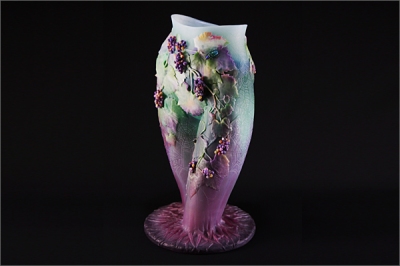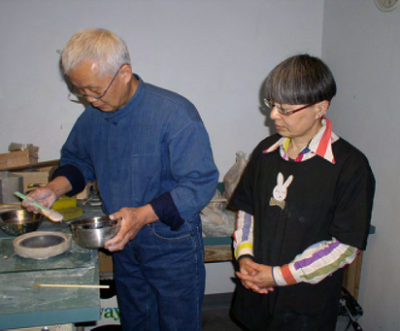 The Higuchi's supplies were destroyed in the March 11 earthquake. courtesy: the artists
The Higuchi's supplies were destroyed in the March 11 earthquake. courtesy: the artists
Husband and wife duo Kimiake and Shin-ichi Higuchi were doing what they do best when the earthquake struck Japan on March 11th: creating highly skillful pâte de verre pieces inspired by the natural world. Leaving their work, they ran outside and watched “windows shatter, walls crumble, and our entire house swaying and moving with the earth.” When the dust settled and the shaking stopped, they looked through the window at their ruined studio — even the 2-ton kilns had moved.
 The interior of the Higuchi's workshop. courtesy: the artists
The interior of the Higuchi's workshop. courtesy: the artists
The Higuchis, who the Corning Museum of Glass described as “the leading artists working in pâte de verre,” are already planning the reconstruction of their studio and repairing their home with architects and contractors. In order to raise funds for this massive undertaking, they are selling all of their works that were not destroyed during the earthquake, each at a discount. The pieces are available by visiting the Mail Order section of their shared website. All other works shown elsewhere on their website are available as well.
 Kimiaki and Shin-Ichi Higuchi, Mother Earth. H 28, W 13 1/2, D 13 1/2 in. courtesy: the artists
Kimiaki and Shin-Ichi Higuchi, Mother Earth. H 28, W 13 1/2, D 13 1/2 in. courtesy: the artists
The Higuchis are selling many pieces that embody traditional Japanese motifs and attitudes toward nature, including colorful vases that look like watercolor paintings and a series of female torsos covered in flora and fauna. Faded spiderwebs, vibrant berries and understates leaves rise from a tree trunk base in Mother Earth, one of several torso pieces available for purchase. The largest pieces—and the only two panels—are mirror-image depictions of a row of blue and purple irises.
 Kimiake and Shin-inchi Higuchi, Iris Panel. H 27, W 142, D 6 in. courtesy: the artists
Kimiake and Shin-inchi Higuchi, Iris Panel. H 27, W 142, D 6 in. courtesy: the artists
Many other works survived, including framed reliefs of flowers such as roses, orchids, and dahlias that look like technicolor cameos; insect-inspired incense cases; and delicate boxes layered with lifelike camellias and daffodils. The bee on a tea container appears trapped in a reddish amber, the veins on a pair of cabbage plates have been touched by a tiny snail, and the floating gardenias look freshly cut.
 The Higuchis leading a pate de verre workshop at CMOG in 2009. courtesy: Mary Mullaney
The Higuchis leading a pate de verre workshop at CMOG in 2009. courtesy: Mary Mullaney
Despite losing their studio, warehouse, and part of their home, the Higuchis remain optimistic. Relating the events on their website, they wrote, “We have lost in a matter of seconds. But all of this, we had initially created from scratch many years ago. We are just back to square one. Together, we have the energy and passion to move forward.”
To see more of the Higuchi’s inventory, visit their website here. For inquiries, they can be reached at higuchi_verre@yahoo.co.jp.


